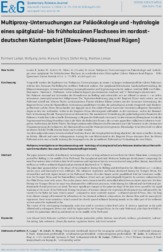Multiproxy-Untersuchungen zur Paläoökologie und -hydrologie eines spätglazial- bis frühholozänen Flachsees im nordostdeutschen Küstengebiet (Glowe-Paläosee/Insel Rügen)
Lampe, Reinhard; Janke, Wolfgang; Schult, Manuela; Meng, Stefan; Lampe, Matthias, 2016: Multiproxy-Untersuchungen zur Paläoökologie und -hydrologie eines spätglazial- bis frühholozänen Flachsees im nordostdeutschen Küstengebiet (Glowe-Paläosee/Insel Rügen). In: E&G – Quaternary Science Journal; Vol.65, No.1, p.41-75, DOI: 10.3285/eg.65.1.03.
 |
Dokument öffnen: |
The paper presents results of multiproxy-investigations of a 3 m long sediment section from the Glowe Palaeolake, covering the period Pre-Bølling to the middle of the Preboreal. The Lateglacial and early Holocene landscape development comprising climate fluctuations, lake evolution, lake-level variations and vegetation history is reconstructed using pollen, diatom, macrofossil, molluscs as well as sedimentological and geochemical data based on 14C-dating.
The palaeolake appeared due to the decay of the permafrost during the Bølling and developed in the Allerød into a 3–4 m deep, species-poor and macrophyte-rich stillwater. The submerse vegetation and fauna decreased during the Younger Dryas, but returned fast and with higher density in the Preboreal. Phases of cooler climate can be parallelized with the Gerzensee oscillation, the Younger Dryas and the Rammelbeek oscillation, which each are palynologically bipartite. In contrast, indications for the Older Dryas were only scarce. The cooler phases were characterized by intensified allochthonous clastic input into the lake. During the Younger Dryas the input was dominated by solifluction processes, while during the Allerød and the Preboreal predominantly fluvial processes occurred. The most significant changes in the palaeoecology of the lake were caused by the rapid warming at the onset of the Preboreal. During the phases of warmer climate the vegetation development was influenced by the vicinity to the Baltic Ice Lake, which caused – compared to more southerly regions – a delayed spread of Pinus. Also, the long term climate changes determined the alterations in the chemical sediment composition, the diatom flora and the macrophyte vegetation. Short term variations, which caused the closely spaced sediment layering mainly in the older part of the sediment section cannot be explained so far.
The course of the outcropping stratigraphic units was used to construct a lake-level curve. It shows a rapid rise in the early Allerød and a subsequent slower rise until the highstand in the Younger Dryas. In the early Preboreal, a fast lake-level fall occurred, the palaeolake silted up and dried out in the middle of the Preboreal.

